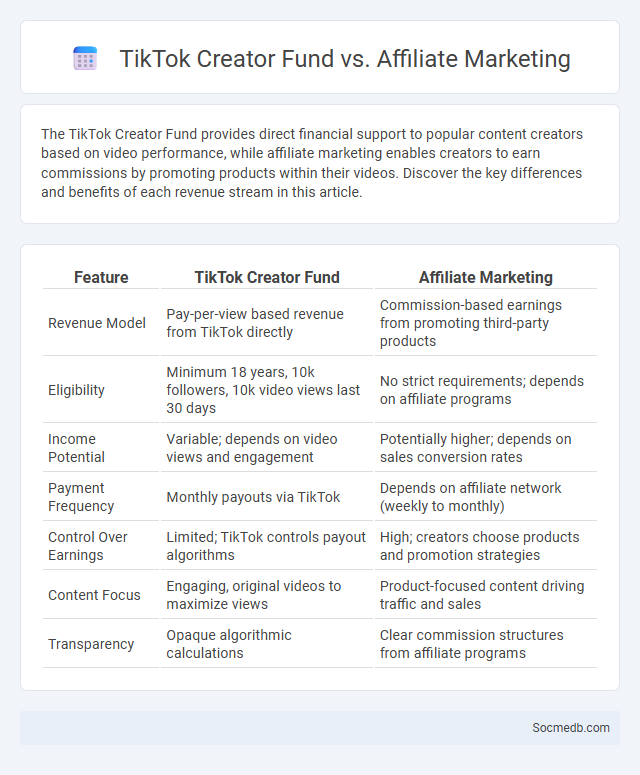
Photo illustration: TikTok Creator Fund vs Affiliate Marketing
The TikTok Creator Fund provides direct financial support to popular content creators based on video performance, while affiliate marketing enables creators to earn commissions by promoting products within their videos. Discover the key differences and benefits of each revenue stream in this article.
Table of Comparison
| Feature | TikTok Creator Fund | Affiliate Marketing |
|---|---|---|
| Revenue Model | Pay-per-view based revenue from TikTok directly | Commission-based earnings from promoting third-party products |
| Eligibility | Minimum 18 years, 10k followers, 10k video views last 30 days | No strict requirements; depends on affiliate programs |
| Income Potential | Variable; depends on video views and engagement | Potentially higher; depends on sales conversion rates |
| Payment Frequency | Monthly payouts via TikTok | Depends on affiliate network (weekly to monthly) |
| Control Over Earnings | Limited; TikTok controls payout algorithms | High; creators choose products and promotion strategies |
| Content Focus | Engaging, original videos to maximize views | Product-focused content driving traffic and sales |
| Transparency | Opaque algorithmic calculations | Clear commission structures from affiliate programs |
Understanding the TikTok Creator Fund
The TikTok Creator Fund allocates millions of dollars to support emerging and established content creators based on views, engagement, and video originality. Creators must meet eligibility criteria including age, follower count, and consistent content posting to qualify for the fund. This program incentivizes high-quality video production, helping creators monetize their content while expanding TikTok's diverse and dynamic community.
What Is Affiliate Marketing on TikTok?
Affiliate marketing on TikTok involves promoting products or services through short videos, where creators include unique affiliate links or codes to track sales. Your engagement with these videos can result in commissions for the creator when viewers purchase items using their links. This strategy leverages TikTok's vast user base and algorithm-driven discovery to maximize brand exposure and sales conversions.
Key Features of the TikTok Creator Fund
TikTok Creator Fund offers financial support to eligible content creators based on video views, engagement, and originality, enabling them to monetize their presence effectively. The fund prioritizes diverse content across multiple genres, rewarding creators who drive high user interaction and maintain consistent posting frequency. Transparent analytics and performance tracking tools empower participants to optimize their content strategy and maximize earnings on the platform.
How Affiliate Marketing Works for TikTok Creators
Affiliate marketing for TikTok creators involves promoting products or services through unique referral links embedded in their video content or bio. Creators earn commissions based on sales or leads generated from their audience clicking these affiliate links, leveraging TikTok's vast and engaged user base. This model allows creators to monetize their influence by integrating authentic product recommendations into short-form video content.
Monetization Potential: Creator Fund vs Affiliate Marketing
Monetization potential on social media varies significantly between Creator Funds and Affiliate Marketing, with Creator Funds offering direct payments based on content engagement metrics, often from platforms like TikTok or YouTube. Affiliate Marketing enables creators to earn commissions by promoting products or services, leveraging personalized tracking links to generate revenue from sales or leads. Affiliate Marketing typically provides higher income scalability and long-term passive income opportunities compared to the fixed, algorithm-driven payouts of Creator Funds.
Eligibility and Requirements for Both Programs
Eligibility for social media programs typically requires participants to be at least 13 years old, complying with COPPA regulations, while some platforms may raise the age limit to 16 or 18 depending on regional laws. Users must meet criteria such as having a valid email address, phone number verification, and adherence to community standards which include content guidelines and privacy policies. Both programs often require consistent activity, such as regular posting or engagement, to maintain account status and access advanced features like advertising or analytics tools.
Payout Structures Compared
Social media platforms offer diverse payout structures, often based on ad revenue sharing, sponsored content, and fan support mechanisms like tipping or subscriptions. TikTok's Creator Fund and YouTube's Partner Program provide earnings linked to video views and engagement, while Instagram emphasizes influencer deals and product promotions. Understanding each platform's monetization methods helps creators optimize income streams effectively.
Pros and Cons: Creator Fund vs Affiliate Marketing
Creator Funds provide consistent income directly from platforms like TikTok or YouTube, rewarding high engagement and content quality, but often require meeting specific eligibility criteria and may limit revenue potential. Affiliate Marketing offers greater earning flexibility by promoting products and earning commissions based on sales, though income can be unpredictable and heavily reliant on audience trust and conversion rates. Choosing between the two depends on factors like content niche, audience size, and the creator's preference for direct platform support versus independent monetization strategies.
Which Option Suits Different Types of TikTok Creators?
TikTok creators can choose from various content options tailored to their niche and audience, such as challenges for trend-driven influencers, tutorials for educational creators, and comedic sketches for entertainment-focused users. Lifestyle vloggers benefit from behind-the-scenes content to build authentic connections, while musicians and dancers excel with performance clips that showcase their talents. Understanding each option's engagement metrics helps creators optimize reach and interaction on the platform.
Choosing the Best Monetization Strategy for TikTok Success
Selecting the optimal monetization strategy for TikTok success involves analyzing audience demographics, content niche, and engagement patterns to target revenue streams effectively. Leveraging TikTok's Creator Fund, brand partnerships, and in-app purchases such as virtual gifts maximizes earning potential through diversified income channels. Consistent content quality, strategic use of trending hashtags, and authentic audience interaction drive follower growth, enhancing monetization opportunities on the platform.
 socmedb.com
socmedb.com